brake Lexus ES350 2012 Owner's Manual
[x] Cancel search | Manufacturer: LEXUS, Model Year: 2012, Model line: ES350, Model: Lexus ES350 2012Pages: 554, PDF Size: 6.43 MB
Page 4 of 554
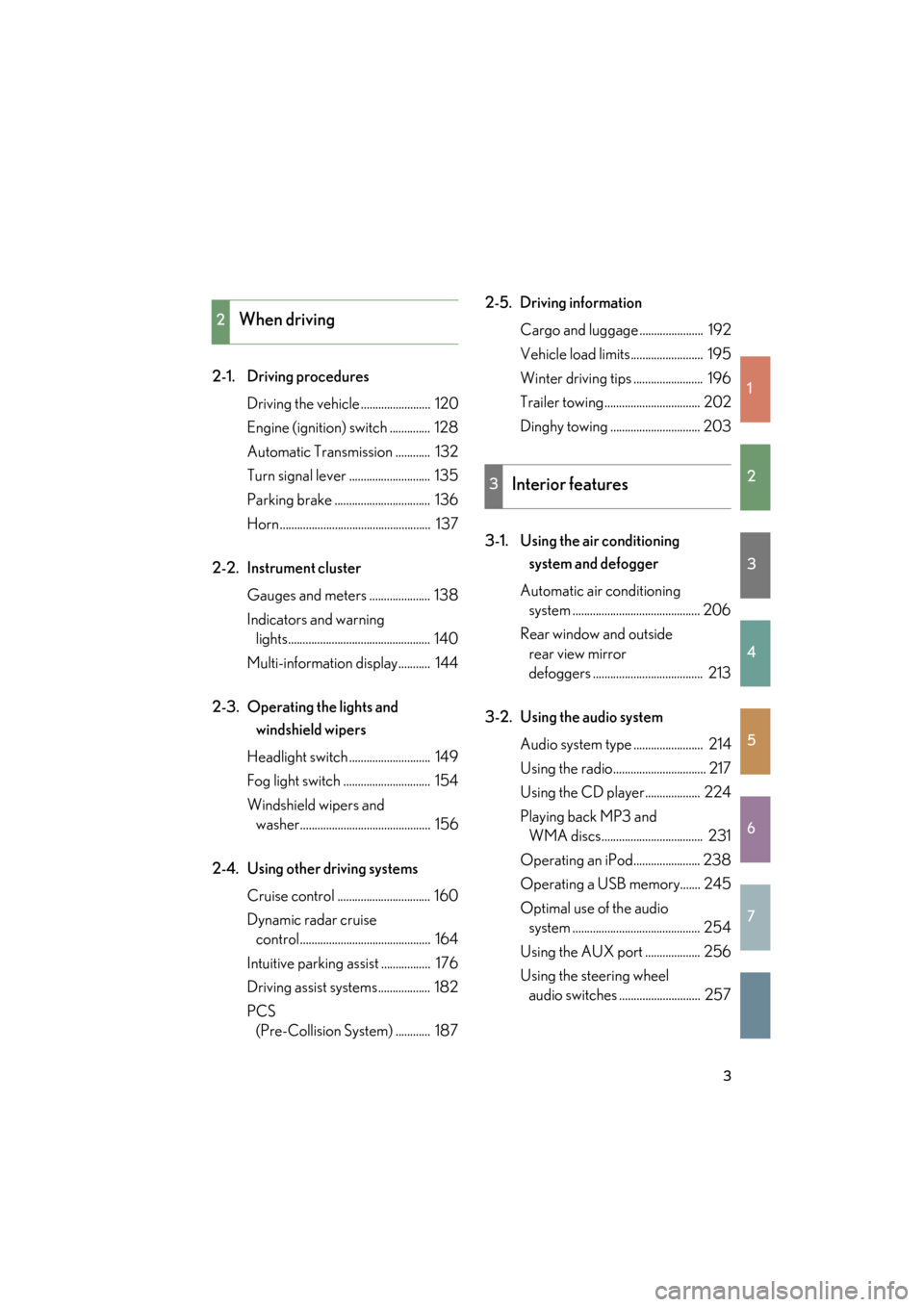
1
2
3
4
5
6
7
3
ES350_U
2-1. Driving proceduresDriving the vehicle ........................ 120
Engine (ignition) switch .............. 128
Automatic Transmission ............ 132
Turn signal lever ............................ 135
Parking brake ................................. 136
Horn.................................................... 137
2-2. Instrument cluster Gauges and meters ..................... 138
Indicators and warning lights................................................. 140
Multi-information display........... 144
2-3. Operating the lights and windshield wipers
Headlight switch ............................ 149
Fog light switch .............................. 154
Windshield wipers and washer............................................. 156
2-4. Using other driving systems Cruise control ................................ 160
Dynamic radar cruise control............................................. 164
Intuitive parking assist ................. 176
Driving assist systems.................. 182
PCS (Pre-Collision System) ............ 187 2-5. Driving information
Cargo and luggage ...................... 192
Vehicle load limits......................... 195
Winter driving tips ........................ 196
Trailer towing ................................. 202
Dinghy towing ............................... 203
3-1. Using the air conditioning system and defogger
Automatic air conditioning system ............................................ 206
Rear window and outside rear view mirror
defoggers ...................................... 213
3-2. Using the audio system Audio system type ........................ 214
Using the radio................................ 217
Using the CD player................... 224
Playing back MP3 and WMA discs................................... 231
Operating an iPod....................... 238
Operating a USB memory....... 245
Optimal use of the audio system ............................................ 254
Using the AUX port ................... 256
Using the steering wheel audio switches ............................ 257
2When driving
3Interior features
Page 15 of 554
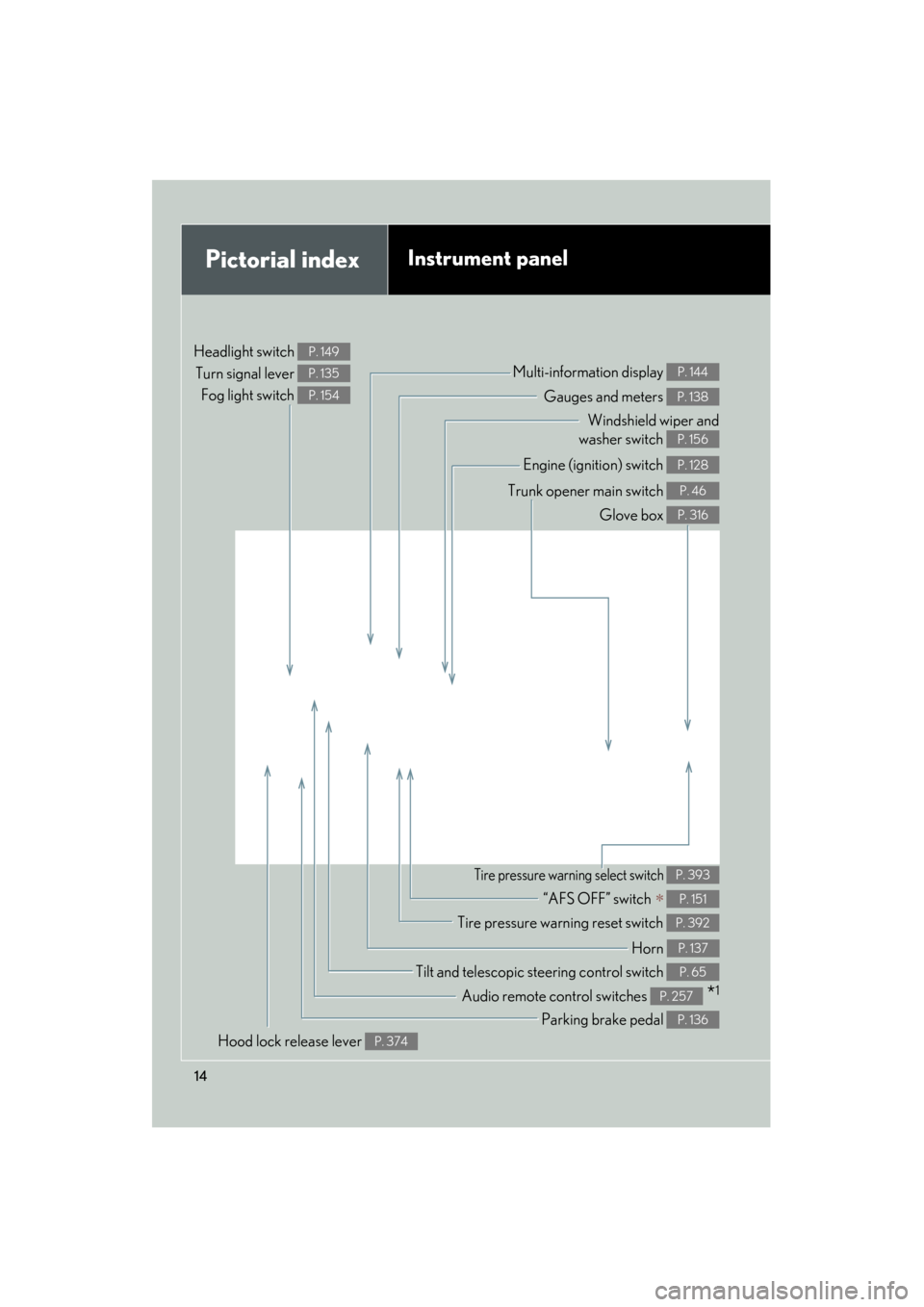
ES350_U
14
Pictorial indexInstrument panel
Headlight switch Turn signal lever Fog light switch P. 149
P. 135
P. 154Gauges and meters P. 138
Multi-information display P. 144
Windshield wiper and
washer switch
P. 156
Engine (ignition) switch P. 128
Trunk opener main switch P. 46
Glove box P. 316
Tilt and telescopic steering control switch P. 65
Parking brake pedal P. 136
Audio remote control switches *1P. 257
Hood lock release lever P. 374
Tire pressure warning reset switch P. 392
“AFS OFF” switch ∗ P. 151
Tire pressure warning select switch P. 393
Horn P. 137
Page 20 of 554
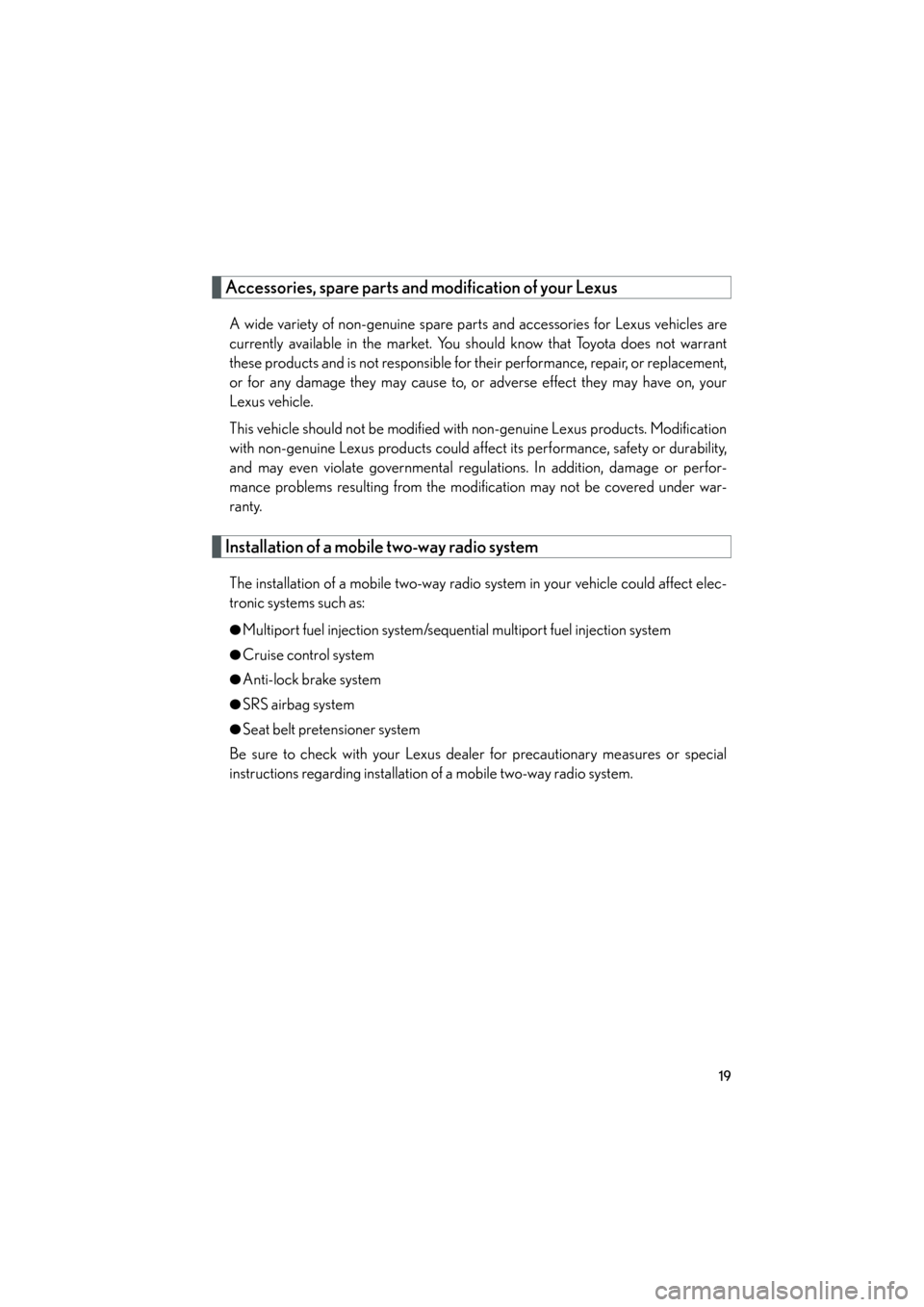
ES350_U
19
Accessories, spare parts and modification of your Lexus
A wide variety of non-genuine spare parts and accessories for Lexus vehicles are
currently available in the market. You should know that Toyota does not warrant
these products and is not responsible for their performance, repair, or replacement,
or for any damage they may cause to, or adverse effect they may have on, your
Lexus vehicle.
This vehicle should not be modified with non-genuine Lexus products. Modification
with non-genuine Lexus products could affect its performance, safety or durability,
and may even violate governmental regulations. In addition, damage or perfor-
mance problems resulting from the modification may not be covered under war-
ranty.
Installation of a mobile two-way radio system
The installation of a mobile two-way radio system in your vehicle could affect elec-
tronic systems such as:
●Multiport fuel injection system/sequential multiport fuel injection system
●Cruise control system
●Anti-lock brake system
●SRS airbag system
●Seat belt pretensioner system
Be sure to check with your Lexus dealer for precautionary measures or special
instructions regarding installation of a mobile two-way radio system.
Page 21 of 554
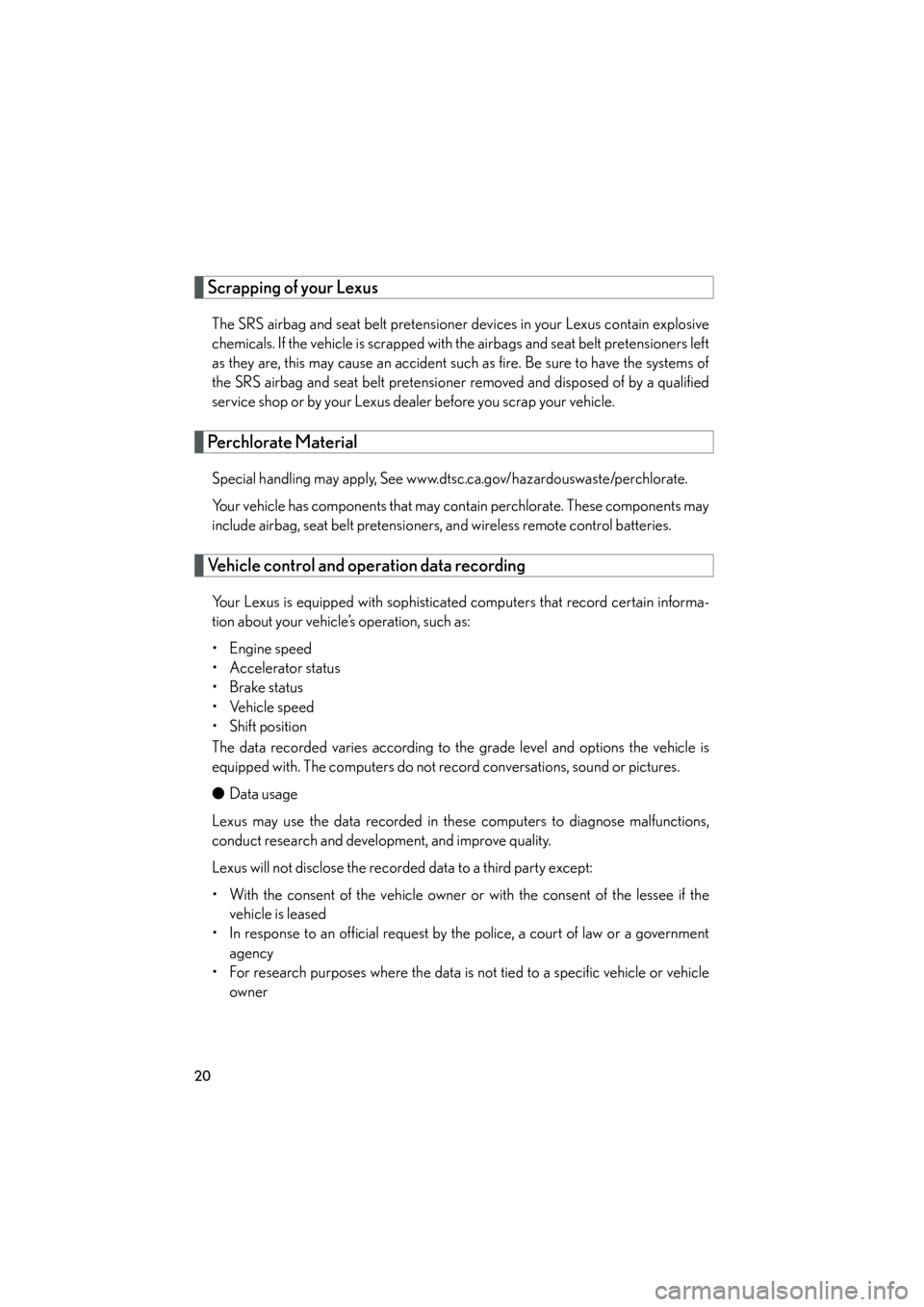
ES350_U
20
Scrapping of your Lexus
The SRS airbag and seat belt pretensioner devices in your Lexus contain explosive
chemicals. If the vehicle is scrapped with the airbags and seat belt pretensioners left
as they are, this may cause an accident such as fire. Be sure to have the systems of
the SRS airbag and seat belt pretensioner removed and disposed of by a qualified
service shop or by your Lexus dealer before you scrap your vehicle.
Perchlorate Material
Special handling may apply, See www.dtsc.ca.gov/hazardouswaste/perchlorate.
Your vehicle has components that may contain perchlorate. These components may
include airbag, seat belt pretensioners, and wireless remote control batteries.
Vehicle control and operation data recording
Your Lexus is equipped with sophisticated computers that record certain informa-
tion about your vehicle’s operation, such as:
• Engine speed
• Accelerator status
• Brake status
• Vehicle speed
•Shift position
The data recorded varies according to the grade level and options the vehicle is
equipped with. The computers do not record conversations, sound or pictures.
● Data usage
Lexus may use the data recorded in these computers to diagnose malfunctions,
conduct research and development, and improve quality.
Lexus will not disclose the recorded data to a third party except:
• With the consent of the vehicle owner or with the consent of the lessee if the vehicle is leased
• In response to an official request by the police, a court of law or a government
agency
• For research purposes where the data is not tied to a specific vehicle or vehicle owner
Page 22 of 554
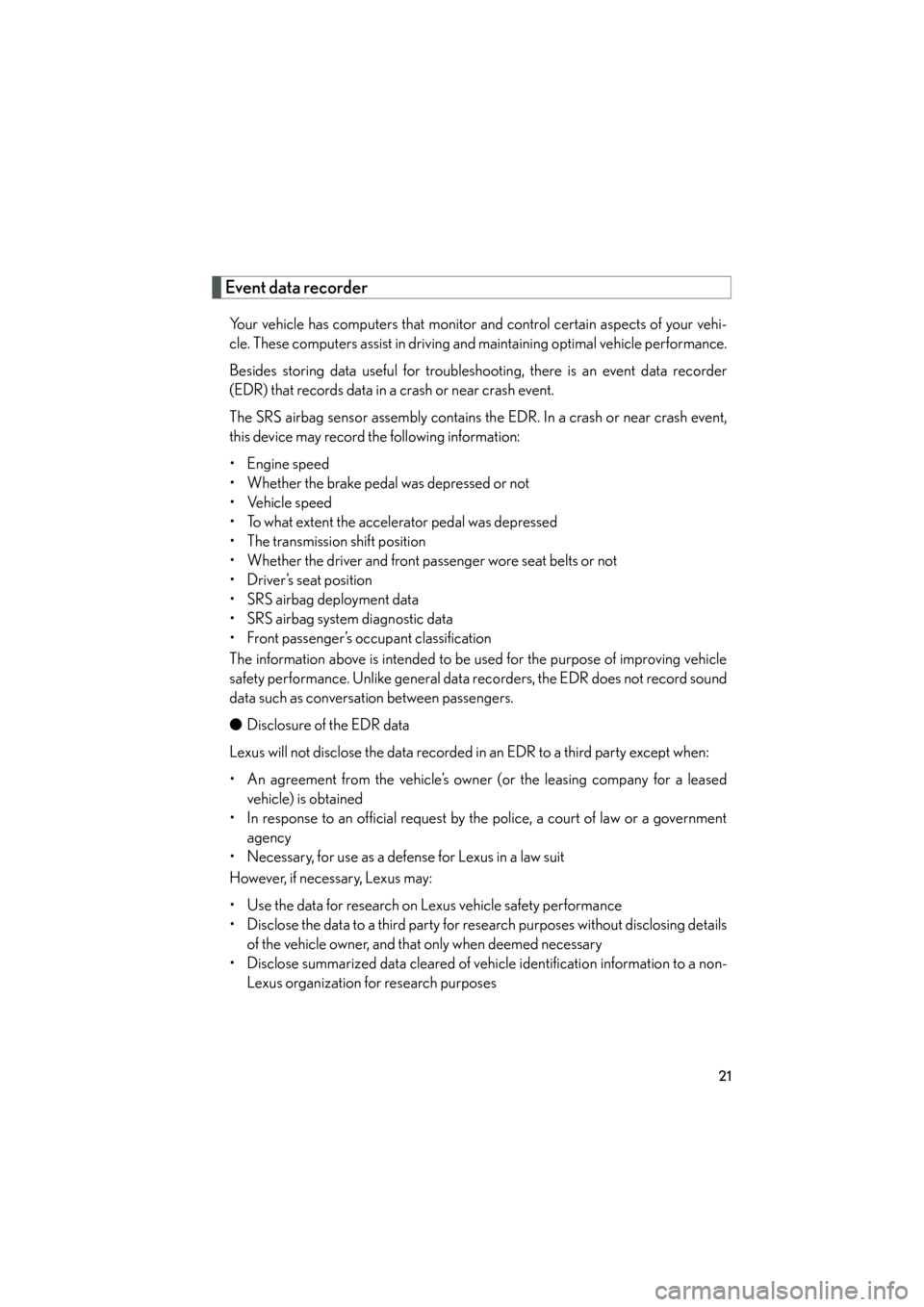
ES350_U
21
Event data recorder
Your vehicle has computers that monitor and control certain aspects of your vehi-
cle. These computers assist in driving and maintaining optimal vehicle performance.
Besides storing data useful for troubleshooting, there is an event data recorder
(EDR) that records data in a crash or near crash event.
The SRS airbag sensor assembly contains the EDR. In a crash or near crash event,
this device may record the following information:
• Engine speed
• Whether the brake pedal was depressed or not
•Vehicle speed
• To what extent the accelerator pedal was depressed
• The transmission shift position
• Whether the driver and front passenger wore seat belts or not
• Driver’s seat position
• SRS airbag deployment data
• SRS airbag system diagnostic data
• Front passenger’s occupant classification
The information above is intended to be used for the purpose of improving vehicle
safety performance. Unlike general data recorders, the EDR does not record sound
data such as conversation between passengers.
●Disclosure of the EDR data
Lexus will not disclose the data recorded in an EDR to a third party except when:
• An agreement from the vehicle’s owner (or the leasing company for a leased vehicle) is obtained
• In response to an official request by the police, a court of law or a government agency
• Necessary, for use as a defense for Lexus in a law suit
However, if necessary, Lexus may:
• Use the data for research on Lexus vehicle safety performance
• Disclose the data to a third party for research purposes without disclosing details of the vehicle owner, and that only when deemed necessary
• Disclose summarized data cleared of vehicle identification information to a non-
Lexus organization for research purposes
Page 120 of 554
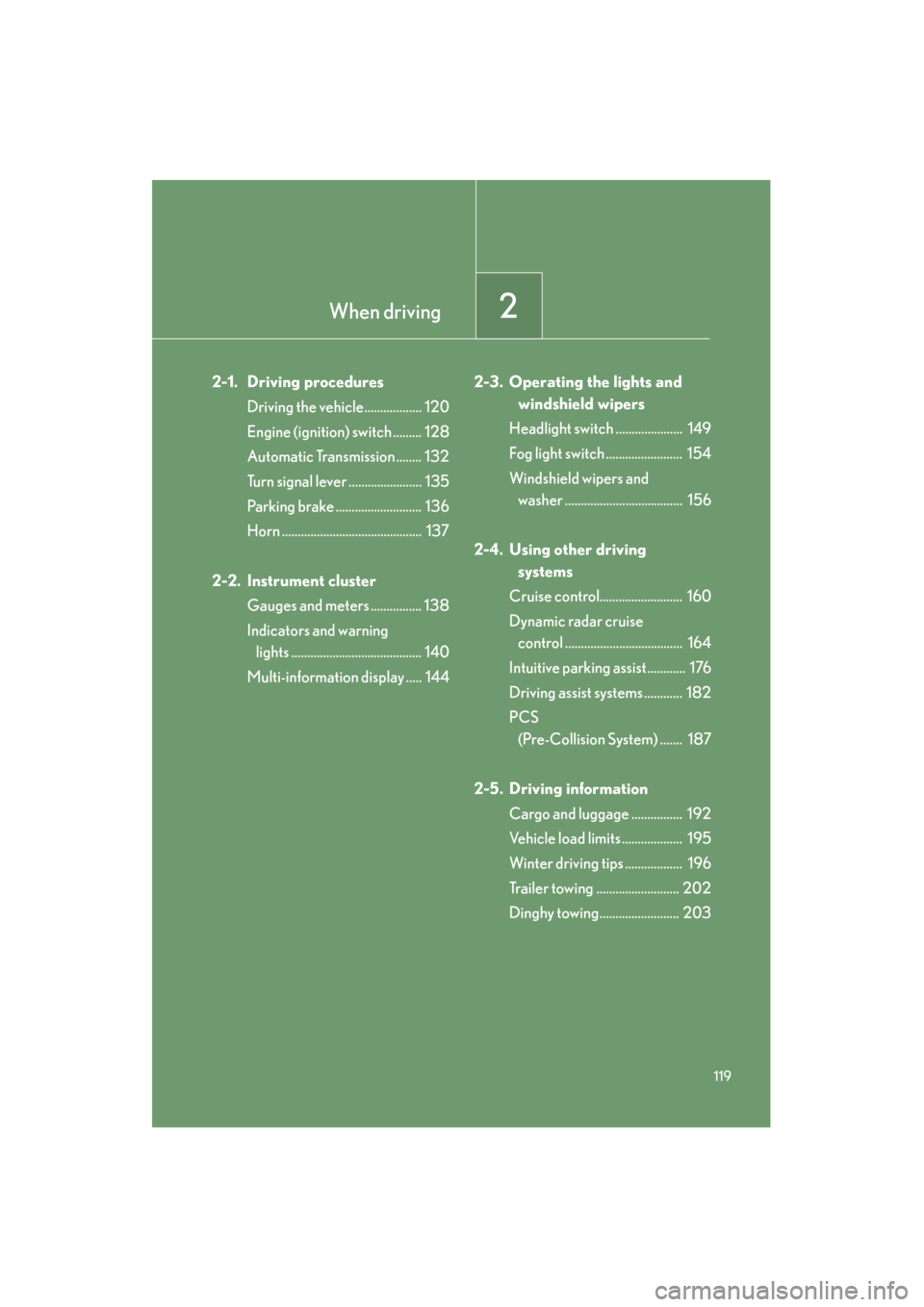
When driving2
119
ES350_U
2-1. Driving proceduresDriving the vehicle.................. 120
Engine (ignition) switch ......... 128
Automatic Transmission ........ 132
Turn signal lever ....................... 135
Parking brake ........................... 136
Horn ............................................ 137
2-2. Instrument cluster Gauges and meters ................ 138
Indicators and warning lights ......................................... 140
Multi-information display ..... 144 2-3. Operating the lights and
windshield wipers
Headlight switch ..................... 149
Fog light switch ........................ 154
Windshield wipers and washer ..................................... 156
2-4. Using other driving systems
Cruise control.......................... 160
Dynamic radar cruise control ..................................... 164
Intuitive parking assist ............ 176
Driving assist systems ............ 182
PCS (Pre-Collision System) ....... 187
2-5. Driving information Cargo and luggage ................ 192
Vehicle load limits ................... 195
Winter driving tips .................. 196
Trailer towing .......................... 202
Dinghy towing......................... 203
Page 121 of 554

120
ES350_U
2-1. Driving procedures
Driving the vehicle
Starting on a steep uphillFirmly set the parking brake and shift the shift lever to D.
Gently depress the accelerator pedal.
Release the parking brake.
The following procedures should be observed to ensure safe driving.
■Starting the engine ( →P. 128)
■ Driving
With the brake pedal depressed, shift the shift lever to D. (→P. 1 3 2 )
Release the parking brake. (→ P. 1 3 6 )
Gradually release the brake pedal and gently depress the
accelerator pedal to accelerate the vehicle.
■ Stopping
With the shift lever in D, depress the brake pedal.
If necessary, set the parking brake.
When the vehicle is stopped for an extended period of time, shift the
shift lever to P or N. (
→P. 1 3 2 )
■Parking the vehicle
With the shift lever in D, depress the brake pedal.
Set the parking brake. (→ P. 1 3 6 )
Shift the shift lever to P. (→ P. 1 3 2 )
Press the “ENGINE START STOP” switch and stop the engine.
Lock the door, making sure that you have the electronic key on
your person.
STEP1
STEP2
STEP3
STEP1
STEP2
STEP1
STEP2
STEP3
STEP4
STEP5
STEP1
STEP2
STEP3
Page 122 of 554
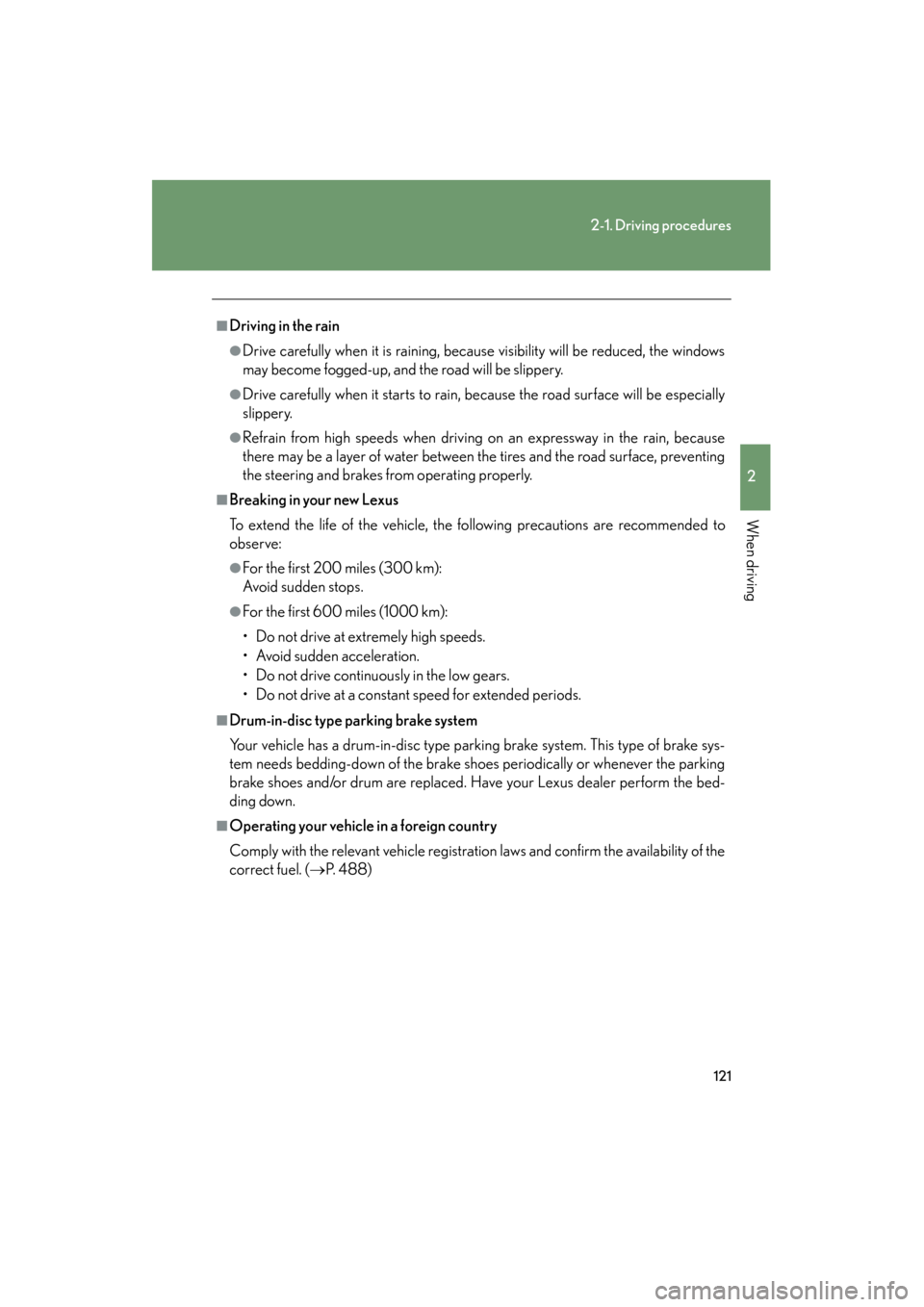
121
2-1. Driving procedures
2
When driving
ES350_U
■Driving in the rain
●Drive carefully when it is raining, because visibility will be reduced, the windows
may become fogged-up, and the road will be slippery.
●Drive carefully when it starts to rain, because the road surface will be especially
slippery.
●Refrain from high speeds when driving on an expressway in the rain, because
there may be a layer of water between the tires and the road surface, preventing
the steering and brakes from operating properly.
■Breaking in your new Lexus
To extend the life of the vehicle, the following precautions are recommended to
observe:
●For the first 200 miles (300 km):
Avoid sudden stops.
●For the first 600 miles (1000 km):
• Do not drive at extremely high speeds.
• Avoid sudden acceleration.
• Do not drive continuously in the low gears.
• Do not drive at a constant speed for extended periods.
■Drum-in-disc type parking brake system
Your vehicle has a drum-in-disc type parking brake system. This type of brake sys-
tem needs bedding-down of the brake shoes periodically or whenever the parking
brake shoes and/or drum are replaced. Have your Lexus dealer perform the bed-
ding down.
■Operating your vehicle in a foreign country
Comply with the relevant vehicle registration laws and confirm the availability of the
correct fuel. (→P. 488)
Page 123 of 554
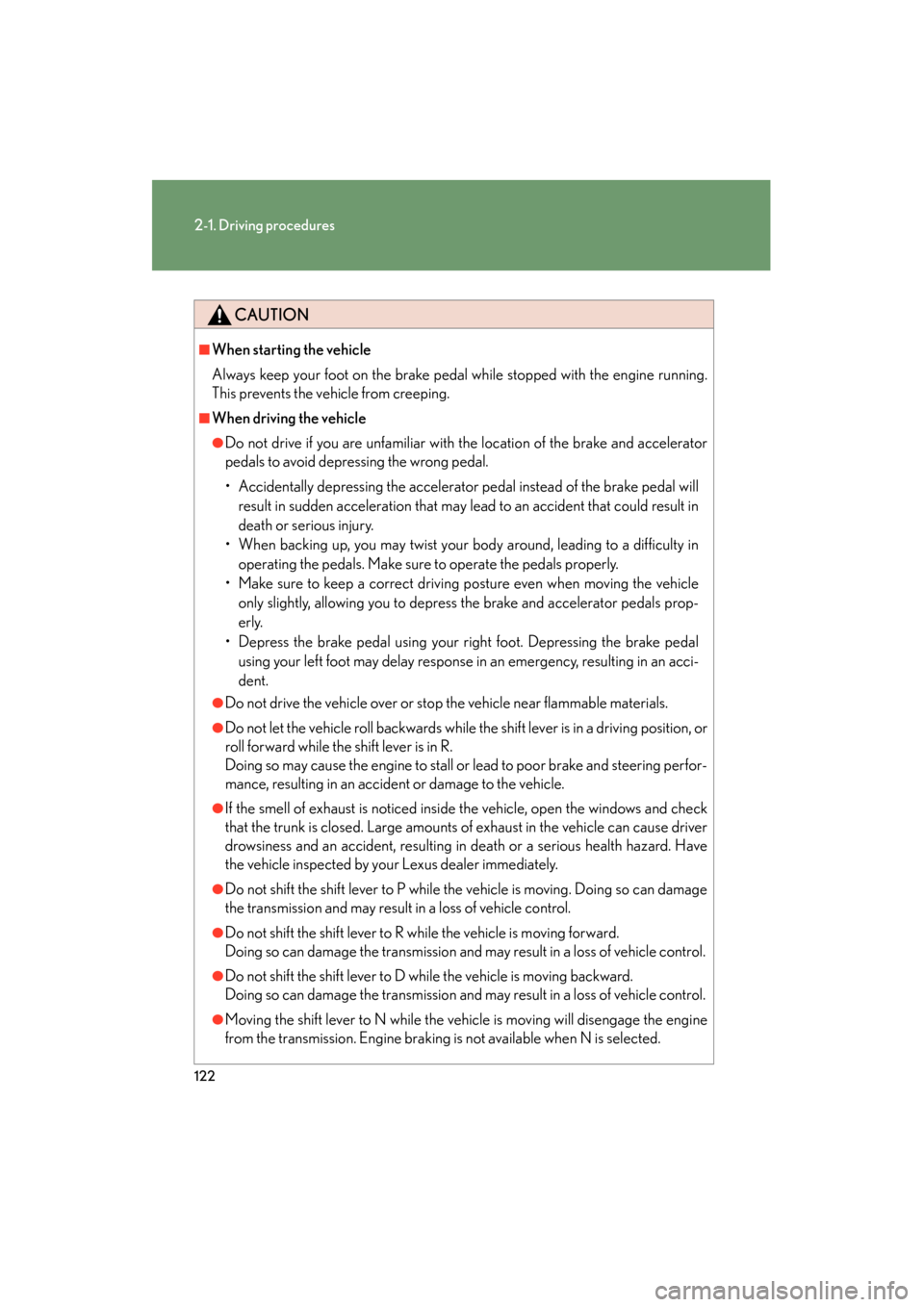
122
2-1. Driving procedures
ES350_U
CAUTION
■When starting the vehicle
Always keep your foot on the brake pedal while stopped with the engine running.
This prevents the vehicle from creeping.
■When driving the vehicle
●Do not drive if you are unfamiliar with the location of the brake and accelerator
pedals to avoid depressing the wrong pedal.
• Accidentally depressing the accelerator pedal instead of the brake pedal willresult in sudden acceleration that may lead to an accident that could result in
death or serious injury.
• When backing up, you may twist your body around, leading to a difficulty in operating the pedals. Make sure to operate the pedals properly.
• Make sure to keep a correct driving posture even when moving the vehicle only slightly, allowing you to depress the brake and accelerator pedals prop-
erly.
• Depress the brake pedal using your right foot. Depressing the brake pedal using your left foot may delay response in an emergency, resulting in an acci-
dent.
●Do not drive the vehicle over or stop the vehicle near flammable materials.
●Do not let the vehicle roll backwards while the shift lever is in a driving position, or
roll forward while the shift lever is in R.
Doing so may cause the engine to stall or lead to poor brake and steering perfor-
mance, resulting in an accident or damage to the vehicle.
●If the smell of exhaust is noticed inside the vehicle, open the windows and check
that the trunk is closed. Large amounts of exhaust in the vehicle can cause driver
drowsiness and an accident, resulting in death or a serious health hazard. Have
the vehicle inspected by your Lexus dealer immediately.
●Do not shift the shift lever to P while the vehicle is moving. Doing so can damage
the transmission and may result in a loss of vehicle control.
●Do not shift the shift lever to R while the vehicle is moving forward.
Doing so can damage the transmission and may result in a loss of vehicle control.
●Do not shift the shift lever to D while the vehicle is moving backward.
Doing so can damage the transmission and may result in a loss of vehicle control.
●Moving the shift lever to N while the vehicle is moving will disengage the engine
from the transmission. Engine braking is not available when N is selected.
Page 124 of 554
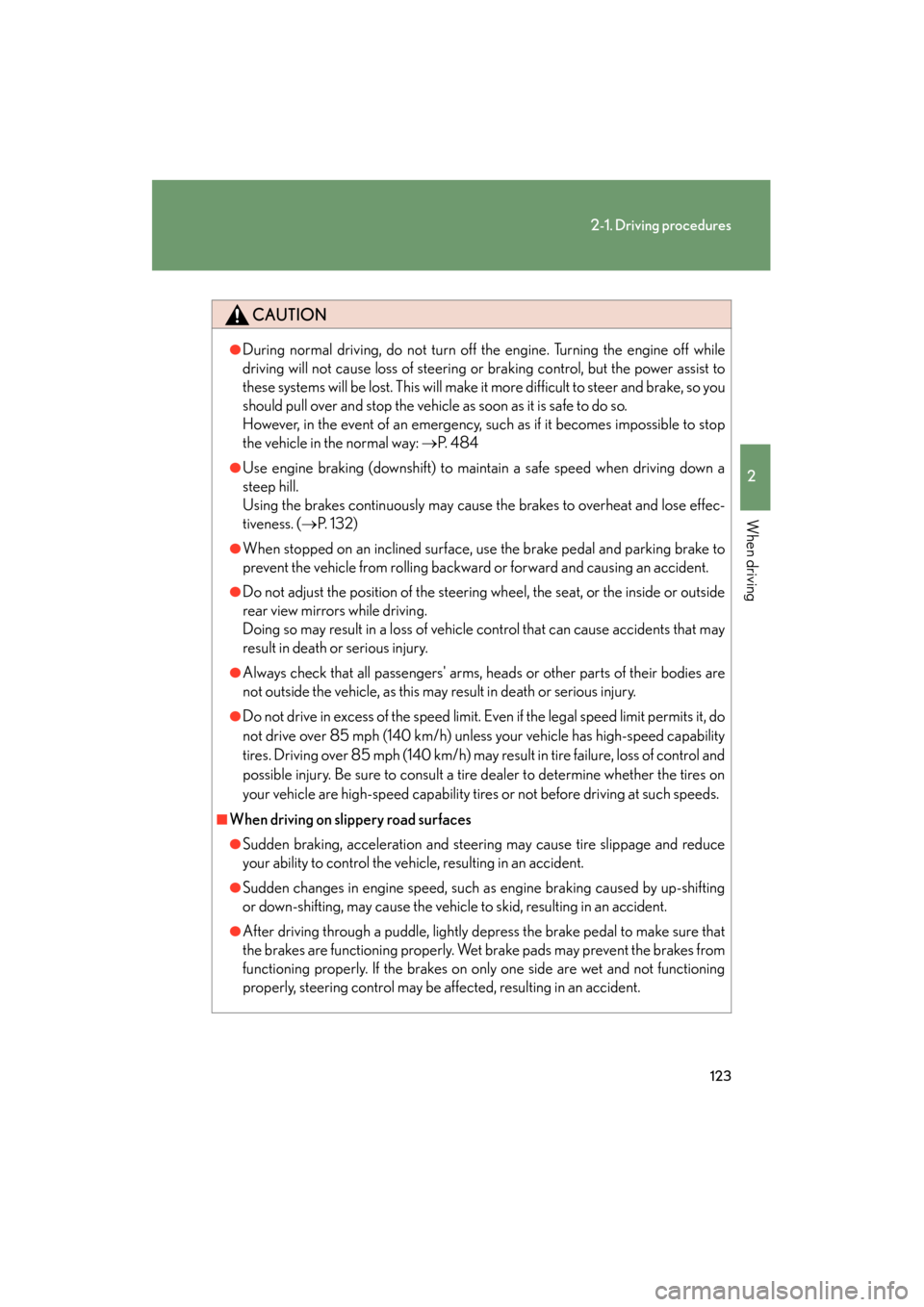
123
2-1. Driving procedures
2
When driving
ES350_U
CAUTION
●During normal driving, do not turn off the engine. Turning the engine off while
driving will not cause loss of steering or braking control, but the power assist to
these systems will be lost. This will make it more difficult to steer and brake, so you
should pull over and stop the vehicle as soon as it is safe to do so.
However, in the event of an emergency, such as if it becomes impossible to stop
the vehicle in the normal way: → P. 4 8 4
●Use engine braking (downshift) to maintain a safe speed when driving down a
steep hill.
Using the brakes continuously may cause the brakes to overheat and lose effec-
tiveness. (→P. 1 3 2 )
●When stopped on an inclined surface, use the brake pedal and parking brake to
prevent the vehicle from rolling backward or forward and causing an accident.
●Do not adjust the position of the steering wheel, the seat, or the inside or outside
rear view mirrors while driving.
Doing so may result in a loss of vehicle control that can cause accidents that may
result in death or serious injury.
●Always check that all passengers' arms, heads or other parts of their bodies are
not outside the vehicle, as this may result in death or serious injury.
●Do not drive in excess of the speed limit. Even if the legal speed limit permits it, do
not drive over 85 mph (140 km/h) unless your vehicle has high-speed capability
tires. Driving over 85 mph (140 km/h) may result in tire failure, loss of control and
possible injury. Be sure to consult a tire dealer to determine whether the tires on
your vehicle are high-speed capability tires or not before driving at such speeds.
■When driving on slippery road surfaces
●Sudden braking, acceleration and steering may cause tire slippage and reduce
your ability to control the vehicle, resulting in an accident.
●Sudden changes in engine speed, such as engine braking caused by up-shifting
or down-shifting, may cause the vehicle to skid, resulting in an accident.
●After driving through a puddle, lightly depress the brake pedal to make sure that
the brakes are functioning properly. Wet brake pads may prevent the brakes from
functioning properly. If the brakes on only one side are wet and not functioning
properly, steering control may be affected, resulting in an accident.